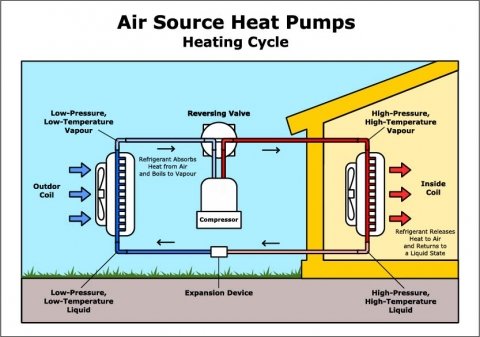Air source heat pumps have become increasingly popular in recent years due to their energy-efficient and eco-friendly performance. However, one common concern among homeowners is the noise generated by these systems, which can be disruptive and annoying. Fortunately, there are several effective methods that DIY users with advanced hands-on skills and technical knowledge can employ to reduce the noise from their air source heat pumps.
Choose and Upgrade to the Latest Air Source Heat Pumps
When purchasing a new air source heat pump, it is crucial to select a model with the lowest noise level. Manufacturers have made significant advancements in noise reduction technology, and the latest heat pump models are significantly quieter than their predecessors.
One example of a modern, low-noise heat pump is the SPRSUN Full DC Inverter Air Source Heat Pump. This model features a remote WIFI APP control feature, which allows users to monitor and adjust the noise level to their preference. The SPRSUN heat pump has a noise level as low as 50 dB, which is significantly quieter than the typical 60 dB noise level of many older heat pump models.
When evaluating potential heat pump models, be sure to carefully review the noise level specifications provided by the manufacturer. Look for models with the lowest decibel (dB) ratings, as this will indicate the quietest operation.
Optimal Location and Surroundings for Air Source Heat Pumps
The installation location of the outdoor unit can have a significant impact on the overall noise level. It is advisable to position the heat pump as far away as possible from bedrooms, living areas, and other spaces where noise can be disruptive.
Additionally, ensure that the installation site is remote from your neighbors’ properties to minimize the impact on their living environment. The best practice is to set the heat pumps on the ground with a chassis damping cushion to prevent vibration and further reduce noise transmission.
When selecting the installation location, consider the following factors:
- Distance from bedrooms and living areas: Aim to place the outdoor unit at least 10-15 feet away from these sensitive areas.
- Proximity to neighbors: Ensure the unit is positioned as far from neighboring properties as possible, ideally with a sound-blocking barrier (e.g., fence, wall) in between.
- Ground surface: Install the heat pump on a stable, level surface, such as a concrete slab or paved area, to minimize vibration and movement.
- Chassis damping cushion: Use a specialized damping cushion or pad beneath the heat pump to absorb vibrations and further reduce noise.
Regular Maintenance and Insulation of Components
Proper maintenance is crucial for maintaining the optimal performance and noise levels of an air source heat pump. Regular checks and inspections can help identify and address any minor issues before they escalate into more significant problems that can contribute to increased noise.
During maintenance, pay close attention to the following components:
- Compressor: Wrap the compressor with a rubber shock pad and spring shock absorber to absorb vibrations and reduce noise.
- Water pumps: Install a sound insulation cover or enclosure around the water pumps to minimize noise transmission.
- Ductwork: Ensure that the ductwork is properly sealed and insulated to prevent air leaks, which can contribute to increased noise.
- Fans: Check the fans for any imbalance or damage, and consider replacing them if necessary to maintain quiet operation.
In addition to maintenance, insulation methods can also help reduce noise from the air source heat pump. Consider using fences, walls, or other sound-blocking barriers to create a physical barrier between the heat pump and the surrounding environment. This can effectively block and absorb noise, preventing it from reaching your living spaces or neighboring properties.
Adjust the Positioning of the Heat Pump
Proper positioning and stabilization of the air source heat pump can also contribute to reduced noise levels. Stabilizing the unit on a solid, level surface, such as a brick or concrete slab, can help minimize movement and vibration, which are common sources of noise.
Additionally, regularly inspecting the heat pump for any signs of damage or wear and tear can help identify potential issues that may be causing increased noise. Addressing these problems promptly can help maintain the quiet operation of the system.
Utilize Sound-Dampening Materials
Incorporating sound-dampening materials into the installation of your air source heat pump can be an effective way to reduce noise. Some options to consider include:
- Sound blanket wrap: Wrapping the outdoor unit in a specialized sound-dampening blanket can help absorb and contain the noise generated by the heat pump.
- Vibration isolation dampener mounts: Installing vibration-dampening mounts beneath the heat pump can help isolate and absorb any vibrations, reducing the transmission of noise.
- Acoustic panels or enclosures: Constructing a custom acoustic enclosure or panels around the outdoor unit can create a physical barrier to block and absorb noise.
When selecting and installing these sound-dampening materials, it is essential to follow the manufacturer’s instructions carefully to ensure proper fit and effectiveness.
Replace the Unit if Necessary
If, after implementing all the above methods, the air source heat pump is still producing an unacceptable level of noise, it may be necessary to consider replacing the unit with a newer, quieter model. The latest generation of heat pumps often feature advanced noise reduction technologies and can provide a significant improvement in sound levels.
When researching replacement options, pay close attention to the noise level specifications provided by the manufacturer. Aim for models with noise ratings of 50 dB or lower, as these will be significantly quieter than the typical 60 dB heat pump.
In addition to the noise level, also consider the overall efficiency, capacity, and other performance characteristics of the new heat pump to ensure it meets your heating and cooling needs.
By following these comprehensive steps, DIY users with advanced hands-on skills and technical knowledge can effectively reduce the noise from their air source heat pumps, creating a more peaceful and comfortable living environment.

